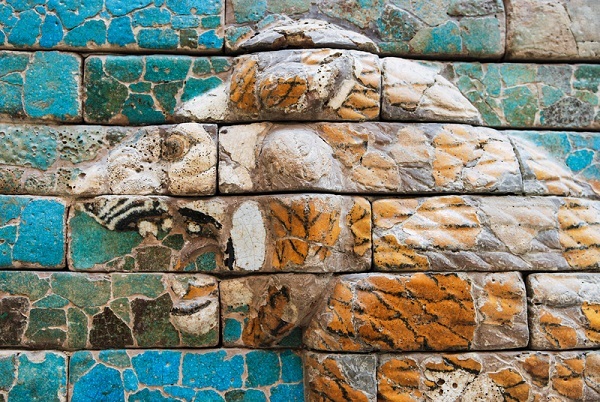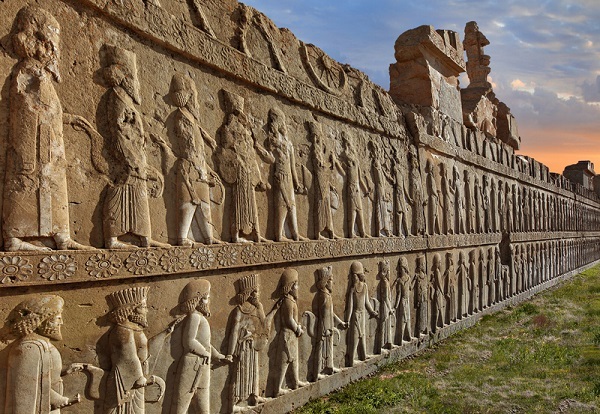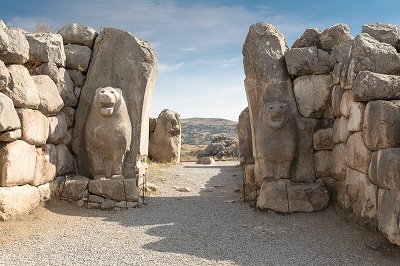

The art and architecture of the ancient Near East encompass the visual arts and architecture produced in the region of the eastern Mediterranean, including Mesopotamia, Egypt, Anatolia, and the Iranian Plateau. This ancient civilization emerged around 4000 BCE and lasted until the conquest by Alexander the Great in the 4th century BCE.
The art and architecture of the ancient Near East are considered some of the most impressive and influential in the ancient world, reflecting the unique cultures and societies of the region. The artworks of the ancient Near East were created using a variety of materials, forms, and functions that reflect the unique cultures and societies of the region.

Ishtar Gate, eighth gate to the inner city of Babylon
One of the most important innovations was the invention of writing, which emerged in Mesopotamia around 3500 BCE. Writing allowed for the recording of information, the creation of literature, and the development of complex societies.
The wheel was another important innovation, which was invented in Mesopotamia around 3500 BCE. The wheel greatly improved transportation and made it possible to construct large-scale structures.
The sail was an innovation that allowed for the development of sea-borne trade and transportation.
The plow was invented in Mesopotamia around 3000 BCE and it greatly improved the efficiency of agriculture.
The innovations of the ancient Near East were not limited to technology and agriculture, but also extended to the fields of mathematics, astronomy, and literature.
The ancient Near Eastern artists used a variety of materials to create their artworks, each of which had its own unique properties and characteristics.
Stone, such as basalt, granite, and limestone, was a common material used for sculptures, reliefs, and architectural elements. These materials were durable, and could be carved into intricate shapes and designs.
Metal, such as bronze, gold, and silver, was used for small-scale sculptures, jewellery, and utensils. These materials were highly valued for their beauty and rarity, and were often used to create objects of prestige and status.
Clay was a versatile material used for pottery, tablets, and seals. It was easy to shape, and could be decorated with a wide range of designs and motifs.
Wood was used for sculptures, furniture, and architectural elements. It was a relatively lightweight material that could be carved and shaped easily.
Textile was used for clothing, tapestries, and other types of fabrics. It was a versatile material that could be used for both practical and decorative purposes, and it was often used to create beautiful and intricate designs.
Sculpture was an important form of art in the ancient Near East. Artists created sculptures of gods, kings, and other important figures, which were often large in scale and were intended to be seen by large numbers of people. These sculptures were made from a variety of materials such as stone, metal, and wood.
Reliefs were another important form of art in the ancient Near East. Artists created reliefs by carving images into stone or clay, and these reliefs were used to depict scenes from mythology and everyday life. Reliefs were used to decorate the walls of temples, palaces, and other public buildings.
Pottery was an important form of art in the ancient Near East. Artists created a wide variety of pottery objects, including jars, cups, bowls, and vases, which were used for both practical and decorative purposes. Pottery was often decorated with a wide range of designs and motifs.
Painting was an important form of art in the ancient Near East. Artists created paintings to decorate the walls of temples and palaces. These paintings were often brightly coloured and depicted scenes from mythology and everyday life.
Architecture was an important form of art in the ancient Near East. Artists designed and constructed a wide range of structures, including temples, palaces, and ziggurat, which were used for religious and political purposes.

Persian Reliefs at Persepolis
Religious function − The ancient Near Eastern artworks were used to depict gods, myths, and rituals. These artworks were created to honour the gods and to ensure the continued favour and protection of the gods.
Political function − The ancient Near Eastern artworks were also used to assert the power and prestige of the ruling classes. These artworks were often commissioned by kings and other powerful individuals, and they were used to showcase their wealth, power, and status.
Funerary function − The artworks of the ancient Near East were also used to commemorate the dead and to provide them with a proper afterlife. These artworks were often placed in tombs and other funerary structures, and they were intended to help the deceased navigate the afterlife.
Decorative function − The artworks of the ancient Near East were also used for decorative purposes. These artworks were used to adorn the walls of temples, palaces, and homes.
In conclusion, the art and architecture of the Ancient Near East are a testament to the creativity, ingenuity, and skill of the people who created them. The artworks of the ancient Near East were created using a variety of materials, forms, and functions, that reflect the unique cultures and societies of the region. The invention of new technologies, ideas, and artistic forms helped to shape the art and architecture of the ancient Near East. The ancient Near East was a land of innovations, where new technologies, ideas, and artistic forms emerged. The art and architecture of the ancient Near East are considered some of the most impressive and influential in the ancient world, and they continue to inspire and captivate people to this day.

Hittite Lion Gate
Q1. What materials were used in ancient Near Eastern art?
Ans. The most common materials used in ancient Near Eastern art were stone, metal, and clay. These materials were abundant in the region and were easily shaped and decorated to create a wide range of artwork, from small figurines to large statues and reliefs.
Q2. How did the forms of Ancient Near Eastern art evolve over time?
Ans. The forms of ancient Near Eastern art evolved over time, reflecting changes in religious and political beliefs, as well as advancements in technology and craftsmanship. Early art forms were primarily focused on religious and spiritual themes, while later forms incorporated more secular and political themes. Additionally, the use of new materials and techniques led to the development of more complex and intricate art forms.
Q3. What role did Ancient Near Eastern artwork play in society?
Ans. Ancient Near Eastern artwork played a significant role in society, serving as a means of religious and political expression, as well as a reflection of the culture and values of the time. Artwork was used in public spaces such as temples and palaces, as well as in private homes, and was often commissioned by rulers or religious leaders to convey specific messages or ideologies.